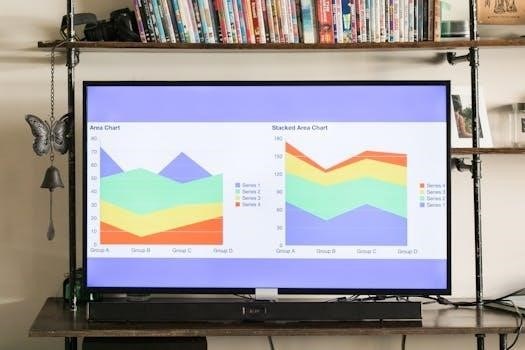Graphing Periodic Trends Worksheet Answers PDF⁚ A Comprehensive Guide
Unlock the secrets of the periodic table with our comprehensive guide to graphing periodic trends worksheets. This resource provides invaluable support for students and educators. Explore atomic radius, ionization energy, and electronegativity through engaging exercises.
Periodic trends worksheets are essential tools for chemistry students, offering a structured approach to understanding the periodic table’s organization and the properties of elements. These worksheets often incorporate graphing activities that visually represent trends in atomic radius, ionization energy, and electronegativity. By plotting data points and analyzing the resulting graphs, students can develop a deeper understanding of how elemental properties change across periods and groups. These worksheets are designed to reinforce key concepts and provide hands-on practice in interpreting and applying periodic trends.
Typically, these worksheets include questions that prompt students to analyze data, draw conclusions, and predict properties of elements based on their position on the periodic table. Many worksheets provide data tables for students to graph, while others require students to research and collect their own data. The use of graphs allows students to visually identify patterns and relationships between atomic number and various elemental properties.
Furthermore, periodic trends worksheets can serve as valuable assessment tools, helping teachers gauge student comprehension of these fundamental chemistry concepts.

Key Periodic Trends Covered
Periodic trends worksheets commonly address several fundamental properties of elements, including atomic radius, ionization energy, and electronegativity. Atomic radius, which refers to the size of an atom, generally decreases across a period and increases down a group. Ionization energy, the energy required to remove an electron from an atom, typically increases across a period and decreases down a group. Electronegativity, a measure of an atom’s ability to attract electrons in a chemical bond, generally increases across a period and decreases down a group.
These trends are crucial for understanding chemical reactivity and the formation of chemical bonds. Worksheets often provide data for students to graph these trends, enabling them to visualize and analyze the relationships between atomic structure and elemental properties. By studying these trends, students gain a deeper appreciation for the periodic table’s organization and its predictive power in chemistry. Understanding these trends is foundational for further studies in chemistry.
Each of these trends plays a vital role in determining the chemical behavior of elements and their interactions with one another.
Atomic Radius
Atomic radius, a key periodic trend, refers to the typical distance from the center of the nucleus to the boundary of the surrounding cloud of electrons. Understanding how atomic radius changes across the periodic table is crucial for predicting and explaining various chemical properties. Generally, atomic radius increases as you move down a group due to the addition of electron shells. As you move across a period from left to right, atomic radius tends to decrease because of the increasing nuclear charge pulling the electrons closer to the nucleus.
Worksheets often require students to graph atomic radii for elements within a group or period, allowing them to visually observe these trends. These graphs help students understand the underlying principles governing atomic size. Analyzing atomic radius trends provides insights into ionization energy, electronegativity, and other properties. Knowledge of atomic radius is fundamental to understanding chemical bonding.
Furthermore, the trends observed in atomic radius help explain the reactivity and behavior of elements in chemical reactions. By studying atomic radius, students develop a deeper understanding of the periodic table and the properties of elements.

Ionization Energy
Ionization energy is the energy required to remove an electron from a gaseous atom or ion. It’s a fundamental periodic trend that reveals information about an element’s electronic structure and reactivity. Ionization energy generally decreases as you move down a group. This is because the outermost electrons are farther from the nucleus and are shielded by more inner electrons, making them easier to remove.
Conversely, ionization energy generally increases as you move across a period from left to right. The increasing nuclear charge attracts the electrons more strongly, making it harder to remove them. Graphing ionization energy trends helps students visualize these patterns and understand the factors that influence them. Worksheets focused on ionization energy often involve analyzing data and predicting relative ionization energies.
Understanding ionization energy is crucial for predicting the formation of ions and the behavior of elements in chemical reactions. Elements with low ionization energies tend to form positive ions (cations), while elements with high ionization energies are less likely to form cations.
Electronegativity
Electronegativity is a measure of an atom’s ability to attract electrons in a chemical bond. It is a crucial concept for understanding the nature of chemical bonds, whether they are polar covalent, nonpolar covalent, or ionic. Electronegativity values are typically based on the Pauling scale, with fluorine being the most electronegative element.
Electronegativity generally increases as you move across a period from left to right. This is because the increasing nuclear charge attracts electrons more strongly. As you move down a group, electronegativity generally decreases. The outermost electrons are farther from the nucleus and are shielded by more inner electrons, reducing the attraction.
Graphing electronegativity trends allows students to visualize these patterns and relate them to the properties of elements. Worksheets on electronegativity often involve predicting the polarity of bonds and molecules based on electronegativity differences. Understanding electronegativity helps predict chemical reactivity and molecular properties. Differences in electronegativity drive chemical interactions.
Graphing Atomic Radius Trends
Graphing atomic radius trends is an essential skill for chemistry students. Visual representation helps in understanding how atomic size changes across the periodic table. Typically, atomic radius is plotted against atomic number to reveal the trends within groups and periods.
Atomic radius generally decreases across a period from left to right due to increasing nuclear charge. The increased positive charge pulls the electrons closer to the nucleus, shrinking the atomic size. Conversely, atomic radius increases down a group as more electron shells are added. The added shells cause the outermost electrons to be further from the nucleus.
Creating graphs of atomic radii for specific groups and periods reinforces these concepts. These graphs illustrate the periodic nature of atomic size. Worksheets often provide data for students to plot and analyze. The process involves selecting appropriate scales, plotting points accurately, and interpreting the resulting graph. Through graphing, students connect abstract concepts to tangible visual representations, enhancing their understanding.
Graphing Atomic Radius for Group 2A
Graphing atomic radius for Group 2A, the alkaline earth metals, provides a clear example of periodic trends. Group 2A includes elements like Beryllium (Be), Magnesium (Mg), Calcium (Ca), Strontium (Sr), and Barium (Ba). As you move down Group 2A, the atomic number increases, and so does the atomic radius.
To create this graph, plot the atomic number on the x-axis and the atomic radius on the y-axis. Input the atomic radius data for each element in Group 2A. Connect the points to visualize the trend. The resulting graph should show a clear upward slope, indicating that atomic radius increases as you descend the group.
Analyzing the graph helps students understand the effect of adding electron shells. Each element down the group adds an additional energy level, pushing the valence electrons further from the nucleus. This increased distance results in a larger atomic radius.
Worksheets often include data tables for Group 2A elements, enabling students to construct these graphs and reinforce their understanding of periodic trends.
Graphing Atomic Radius for Period 3
Graphing atomic radius for Period 3 elements (Sodium to Argon) demonstrates another crucial periodic trend. In Period 3, elements are arranged sequentially, with increasing atomic numbers. Unlike groups, atomic radius generally decreases across a period from left to right.
To graph this, plot atomic number (Na=11 to Ar=18) on the x-axis and atomic radius on the y-axis. Input atomic radii for each element⁚ Sodium (Na), Magnesium (Mg), Aluminum (Al), Silicon (Si), Phosphorus (P), Sulfur (S), Chlorine (Cl), and Argon (Ar).
The graph reveals a decreasing trend. The nuclear charge increases across Period 3, pulling electrons closer to the nucleus and shrinking the atomic radius. Although there might be minor fluctuations, the overall trend is a decline from Sodium to Chlorine, with Argon being an exception due to its stable electron configuration.

Worksheets provide data for this exercise, helping students visualize how effective nuclear charge influences atomic size within the same energy level. Analyzing this graph reinforces understanding of periodic trends.
Electronegativity and Atomic Radius Relationship
The relationship between electronegativity and atomic radius is an inverse one, providing valuable insights into chemical behavior. Electronegativity, the ability of an atom to attract electrons in a chemical bond, is strongly influenced by atomic size. As atomic radius increases, the electronegativity generally decreases.
Larger atoms have their valence electrons farther from the nucleus, reducing the effective nuclear charge experienced by these electrons. This weaker attraction makes it more difficult for the atom to attract additional electrons, resulting in lower electronegativity. Conversely, smaller atoms have valence electrons closer to the nucleus, leading to a stronger attraction for electrons and higher electronegativity.
Understanding this inverse relationship helps predict bond polarity and chemical reactivity. Elements with significantly different electronegativities form polar bonds, while those with similar electronegativities form nonpolar bonds. The periodic trends worksheets often include exercises that explore this connection, reinforcing the fundamental principles governing chemical interactions. Recognizing this interplay is crucial for grasping chemical properties.
Analyzing Electronegativity vs. Atomic Radius Graphs
Analyzing graphs plotting electronegativity against atomic radius reveals crucial periodic trends. These graphs visually represent the inverse relationship, demonstrating how changes in atomic size affect an element’s ability to attract electrons. Typically, as you move down a group, atomic radius increases, and electronegativity decreases.
Conversely, moving across a period from left to right, atomic radius decreases, and electronegativity generally increases. The graphs highlight exceptions and nuances, such as the influence of electron shielding and effective nuclear charge. Students can identify elements with high electronegativity and small atomic radii, indicating strong electron-attracting capabilities.
Conversely, elements with low electronegativity and large atomic radii exhibit weaker attractions. Analyzing these graphs enhances understanding of chemical bonding and reactivity. These analyses are essential for predicting molecular properties and reaction outcomes. Graphing exercises reinforce the periodic trends, promoting a deeper understanding of fundamental chemical principles. Through careful examination, patterns emerge, leading to insightful conclusions about elemental behavior.
Using Worksheets for Assessment and Practice
Worksheets are invaluable tools for assessing student understanding and providing ample practice in grasping periodic trends. These resources offer a structured approach to reinforcing concepts related to atomic radius, ionization energy, and electronegativity. Worksheets can include various question types, from multiple-choice questions that test recall to graphing exercises that promote analytical skills.
By completing worksheets, students actively engage with the material, solidifying their knowledge. The graphing components of the worksheets encourage visual representation of trends, enhancing comprehension. These activities allow educators to identify areas where students may struggle, enabling targeted instruction. Furthermore, worksheets offer a convenient method for tracking student progress throughout the unit.
Regular practice with these materials builds confidence and mastery of periodic trends. Educators can use worksheet results to tailor their teaching methods, ensuring that all students grasp the fundamental principles. The versatility of worksheets makes them ideal for both in-class activities and homework assignments.
Availability of Answer Keys in PDF Format
Answer keys in PDF format are readily available for graphing periodic trends worksheets, providing a valuable resource for both students and educators. These answer keys offer a convenient way to check work, identify errors, and reinforce understanding of key concepts. The PDF format ensures easy access and compatibility across various devices, making them ideal for use in the classroom or at home.
Educators can utilize answer keys to quickly assess student performance and provide targeted feedback. Students can benefit from reviewing the correct answers to identify areas where they need additional practice. The availability of answer keys promotes self-assessment and independent learning, empowering students to take ownership of their understanding.
Furthermore, answer keys in PDF format often include detailed explanations of the solutions, enhancing comprehension of the underlying principles. This feature is particularly useful for students who struggle with specific concepts. By providing clear and concise explanations, answer keys facilitate a deeper understanding of periodic trends and their applications.

Applications of Understanding Periodic Trends
Understanding periodic trends has wide-ranging applications across various scientific disciplines. In chemistry, it is crucial for predicting chemical reactivity, understanding bonding behavior, and designing new materials with specific properties. By knowing how atomic radius, ionization energy, and electronegativity vary across the periodic table, chemists can make informed predictions about how elements will interact.
In materials science, periodic trends guide the development of advanced materials with tailored characteristics. For example, understanding electronegativity differences is essential for creating semiconductors with desired electronic properties. Similarly, knowledge of atomic radii helps in designing alloys with specific strength and density.
Furthermore, periodic trends are essential in environmental science for predicting the behavior of pollutants and designing remediation strategies. Understanding how elements interact with the environment, based on their position in the periodic table, is crucial for addressing environmental challenges.
In medicine, periodic trends play a role in drug design and development. By understanding how elements interact with biological systems, researchers can create more effective and targeted therapies.